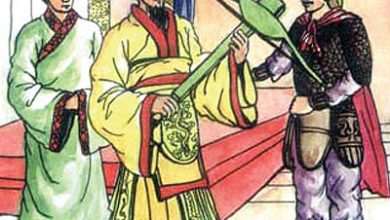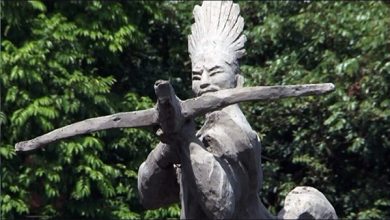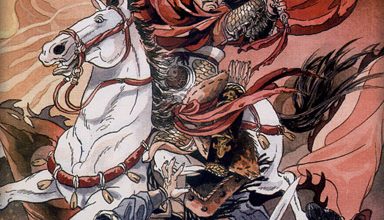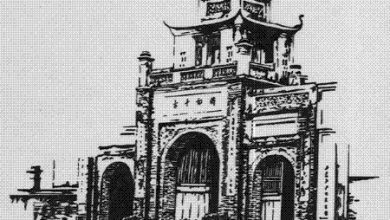The resistance war against the Qin Dynasty and the foundation of Au Lac State
The foundation of Qin Empire was the inevitable result of a long and complicated history, marking a new development of China with the establishment of a strong centralized monarchy. In 221 BC, the Qin defeated six countries in the war among “seven powers” in Warring States and acquired the entire Chinese territory. The king of the Qin, Doanh Chinh self-proclaimed Emperor Qin and set up a centralized autocratic monarchy.
As for internal affairs, the Qin implemented an active policy of agricultural development, industrial and commercial expansion, writing, monetary unit and measurement consistency, indicating a stride of Chinese history. But the Qin was a tyrannical totalitarian regime.
As for foreign affairs, the Qin launched a large-scale war to conquer the North and mostly the South, founding the first vast empire in Chinese history.
In 215-215 BC, Qin Shi Huang sent troops to defeat the Xiongnu and occupied the southern area of Ha Sao. Basing on the rampart of 3 former countries Qin, Yen and Zhao, the Qin built into a new wall of 5,000 miles long running from Lam Thao in the west to Lieu Dong in the east. It was the famous Great Wall of China, aiming at preventing the advance of the Xiongnu and protecting the northern border of the Qin Empire.
To the South, follow the policy of “ruling Bach Viet” of the former Chu, Qin Shi Huang sent 50 thousand troops to invade the land of Bach Viet in the south of the Yangtze.
According to historical evidence, the historical researchers think that it can be roughly defined: the Qin army started the invasion of Bach Viet in 218 BC.
According to Huainan Zi, 500 thousands Qin soldiers were divided into five armies, in which two armies garrisoned in Dam Thanh and Cuu Nghi Mountain Passes invaded Quang Tay, the land of Tay Au (or Au Viet). Their food boats went upstream Tuong River which flowed from Ngu Linh Mountain to Dong Dinh Lake. However, when they reached the origin of Tuong River, there was no waterway to Ly River aka Que River, to enter Quang Tay. So, Do Thu commanded Giam Loc to “order troops to dig canals to transport food” (Huainan Zi). That was Linh Cu Canal or Hung An Canal connecting Tuong River to Ly River, which still exists. Loc was a Viet resident who was holding the position of court counselor under the Qin Dynasty. Because Loc understood the terrain of Linh Nam and was good at waterway, Do Thu assigned him to take charge of the transportation of food and digging of Linh Cu Canal to connect Tuong River to Ly River.
In the 3 years (218 – 215 BC) since the dispatch of troops, the Qin had to dig canal and deal with the struggle of the Viet people, thus “three-years without taking off armors” (Huainan Zi). Then, thanks to Linh Cu Canal, the Qin soldiers moved to Ly River (Que River) and then into the Tay Giang River basin which was the area of Tay Au tribe. Qin troops killed a chief of Tay Au tribe, i.e. Dich Hu Tong, but they had to face fierce resistance of the Viet people.
In 214 BC, the Qin conquered Luc Thuong and set up the land into three districts: Nam Hai, Que Lam and Tuong. Nam Hai was Quang Dong region (invaded by the third army). Que Lam was the northern and eastern part of Quang Tay. Tuong County was in the west of Quang Tay and a part of southern Que Chau. Thus, the three districts of Nam Hai, Que Lam and Tuong captured by Qin troops were within Quang Dong, Quang Tay and a part of Que Chau in southern China. When setting up Nam Hai, Que Lam and Tuong Districts, Qin troops had entered the Tay Giang basin and basically occupied this area. On the verge of victory, with the favorable waterway for transporting food, of course Qin soldiers did not stop there. From Tay Giang, Qin troops could go downstream Ta Giang and Ky Cung Rivers to the north and northeast of Vietnam. Tay Au and Lac Viet tribes stood up to fight against the Qin invaders. There was no record of this struggle; however, Ly Ong Trong legend partly reflects the clash between the Qin and An Duong Vuong.
“Lĩnh Nam chích quái” (Stories of ghosts and spirits in Lĩnh Nam) had a story about Ly Ong Trong as follow: “At the end of Hung King’s reign, there was a person in Huong Thuy commune, Tu Liem district, in Giao Chi, named Ly Than. He was enormous; he was presumptuous and often killed people. He deserved to be killed, but Hung King kept him alive. To the An Duong Vuong time, Qin Shi Huang wanted to send troops to attack our country. Ly Than paid was paid tribute to the Qin by King An Duong Vuong”.
Thuc Phan was a leader of Tay Au tribe in the north of Van Lang State at that time including the southern part of Quang Tay and the center was Cao Bang. After the chief of Tay Au tribe, Dich Hu Tong sacrificed, Thuc Phan and many other leaders of Tay Au and Lac Viet tribes continued to fight against the Qin.
Prior to the initial strength of the Qin army, “the Viet people stay in the forest with animals; no one let himself captured by the Qin army” (Huainan Zi), “Viet people fled” (Chronicles). It was not an escape because of fear and failure; on the contrary, it was a way to fight against the enemy. The Viet people withdrew into the forest to avoid strength of the Qin army at the beginning; they did not want to combat when they did not have favorable conditions. In the meantime, “together, they selected talents to become generals and led the military to fight against the Qin at night” (Huainan Zi). Obviously, this was a tenacious, intelligent and organized combat. Viet people relied on the social structure of available tribes, made use of jungle terrain to endure a long-term resistance war. They chose to fight in small groups and at night or ambush to drain the enemy and plunder their food sources. It can be said that this was an embryo of guerilla war.
The ingenious, durable resistance of the Viet military made the Qin “lack of food” and “garrison in useless land; face dilemma” (Old historical documents). The Invaders were increasingly drawn into tension, danger and despair.
At that time, the Viet people gathered forces and fight back to destroy enemy forces, crushing the invasion of the Qin army. As a result, the Viet people “crushed the Qin army and killed Do Thu. Tens of thousands of the Qin troops were annihilated” (Huainan Zi). In 208 BC, the Qin soldiers were disarmed.
Bach Viet invasion war of the Qin Dynasty lasted 10 years (218-208 BC). Many Viet groups participated in the war against the Qin and helped destroy the Qin army. The resistance war against the Qin by the people of Tay Au and Lac Viet in the territory of Van Lang-Au Lac State lasted about 5 or 6 years, from about 214 BC to 208 BC.
The war against the Qin was the first historical conflict between Viet people with a Great Han Empire in China. It was the resistance of a nation fighting against the invasion of a brutally powerful empire in the East.
Facing fierce challenges, Viet people won a glorious victory. Qin troops were heavily defeated, “crushed”, knocked out of Viet country and had to gather troops to keep the three districts established in the north of country.
The five to six years fight further strengthened the inherent unity between Tay Au and Lac Viet people. The glorious victory of the resistance reinforced and enhanced the prestige of Thuc Phan in Tay Au community as well as Lac Viet community.
All events taken place before and during the war against the Qin were the preparation for the foundation of Au Lac State to replace Van Lang State and transferred the throne from Hung King to An Duong Vuong Thuc Phan.






